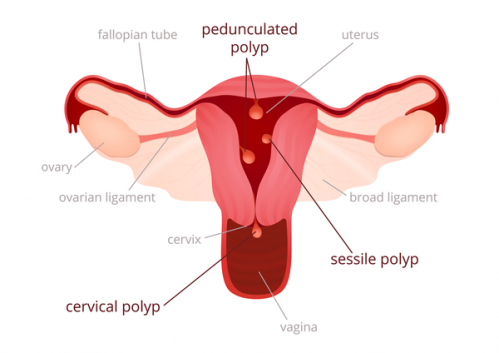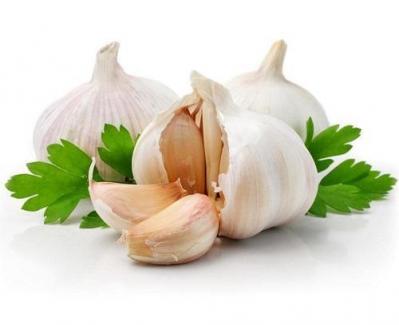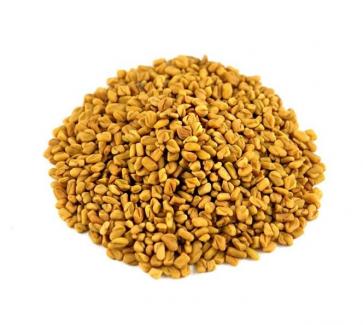What is a uterine polyp?
The uterine polyp is a mass of tissue that develops inside the uterus as a small, soft growth in the uterine wall. These are fragile structures that develop from stems rooted on the surface of the cervix or inside the cervical canal. It is possible to distinguish two types of polyps according to their shape:
- Pedunculated polyp
It has a pedicle, that is to say an elongated and fine structure which connects it to the wall of the uterus.
- Sessile polyp
It is attached to the uterus by a wider, flat base.
According to Harvard University, uterine polyps are most common in women 40 to 50 years old who have more than one child. Statistics indicate that about 25% of women have uterine polyps. Uterine polyps almost never occur in young women before menstruation begins. Uterine polyps are also common during pregnancy.
Natural treatment for uterine polyps
-
Natural remedy based on medicinal plants, roots and bark
First, if your gynecologist comes to diagnose the presence of a uterine polyp, don't panic. Because uterine polyps are mostly benign non-cancerous tumors. The natural treatment that we offer to cure your polyps naturally includes several 100% natural herbal teas. It is an effective, fast and long-lasting natural remedy that can permanently eradicate polyps. It is very effective with a 100% satisfaction rate. All the elements of our treatment are entirely based on natural plants. To discover our natural remedy against uterine polyps click here!
To contact our experts please call or write to us on the following number, tel / WhatsApp
: 0022996374527
We deliver our products all over the world within 24 hours by DHL. Payment will be made after receipt of your order.
-
garlic
Garlic has antifungal and antioxidant properties which not only destroy the fungi which can cause uterine polyps, but also eliminate harmful free radicals from the body and eliminate them entirely. Consumption of 3 to 4 cloves of garlic with a glass of water in the morning.
-
Citrus
Fruit types such as lemons naturally contain acids which are considered to be drugs to treat uterine polyps.
-
Essential oils
One of the home remedies to treat uterine polyps that contain essential oils. Take a little amount of oregano oil and add to some boiling water.
-
Onion
Shallots are ingredients that can inhibit the growth of uterine polyps. You can include shallots in the kitchen.
-
Gooseberry or Amla
Gooseberry and Amla are rich in vitamin C. Both can strengthen the tissue of the mucosa, which helps maintain elasticity. You can drink a teaspoon of gooseberry powder with a glass of water each morning for best results.
-
Dandelion and burdock
Use these two herbs in the same amount. A tablespoon of this herbal mixture is poured into boiling water for 30 minutes. After cooling, filter. Medication should be taken daily. The therapy lasts 2 months.
-
Tisane
It is proven that consuming herbal tea every day is a way to overcome uterine polyps. Herbal teas improve immunity and help regulate the reproductive system.
-
Fenugreek
Fenugreek can relieve periods of menstruation. Indeed fenugreek is used for the treatment of menorrhagia. Menorrhagia corresponds to very violent menstruation, characterized by strong, prolonged and severe bleeding which can affect a woman's daily activities during the menstrual cycle.
-
Sports
Sport is essential for stayin healthy and active. When you are in good shape, you have more chances to avoid the disease. Regular exercise with a controlled diet can help control the effects of uterine polyps.
Causes of uterine polyps
Although the causes of uterine polyps is not exactly known, doctors believe that oestrogen plays an important role in their development. During the menstrual cycle, the level of oestrogen in the blood changes, preparing the endometrium for possible pregnancy. If the embryo does not attach, menstruation occurs.
If the oestrogen level is high, the lining of the uterus may thicken further and these polyps appear. Another cause of their appearance can be the congestion of blood vessels in the cervical canal.
Risk factors
Any woman has a risk of developing uterine polyps, but it increases in the following cases:
• obesity or overweight
• breast cancer treatment
• high blood pressure
Symptoms of the disease
Uterine polyps can have the following symptoms:
-irregular menstrual bleeding;
- vaginal bleeding between menstruations;
-infertility;
- painful and abundant periods;
- bleeding after sexual contact;
-vaginal bleeding after menopause.
Radio imagistic and laboratory investigations
If the existence of uterine polyps is suspected, the following investigations are recommended:
-Transvaginal ultrasound
-Hysteroscopy: aims to diagnose and treat polyps
- Curettage: the procedure is carried out to take a sample to be tested in the laboratory or even to remove the polyp. Most polyps are not cancerous.
Diagnosis of uterine polyps
Uterine polyps can be discovered with simple gynecological control, and their early detection prevents complications and infertility. Do not delay the annual gynecological medical check-up!
Medical treatment of uterine polyps
In most cases, the gynaecologist recommends the removal of uterine polyps, especially if it causes bleeding or infertility. If the polyps are very small, they are kept under observation. If the tumours are proven to be malignant, a hysterectomy is recommended. Operative hysteroscopy is the treatment par excellence of the uterine polyp. The surgical procedure will remove the entire polyp, including the area on which the uterine polyp is implanted. Sometimes the adjacent mucosa will also be removed during the same operating time, when it is too thick, especially when the patient is menopausal. An endometrial resection or endometrectomy will then be performed.
Evolution, complications, prophylaxis
A controversial idea is that the existence of uterine polyps leads to infertility. According to studies, infertile women from whom uterine polyps were surgically removed had a much higher chance of becoming pregnant after artificial insemination, compared to patients who had been inseminated without their polyps removed.
The increased risk of miscarriage in women using IVF is also linked to their presence (if the doctor did not recommend removing the polyps before in vitro fertilization).
Medical recommendations
Uterine polyps, even if they have been surgically removed, can reappear after a while. This is why a regular gynecological examination is recommended.
We hope you found this article useful!
To contact our experts please call or write to us on the following number, tel / WhatsApp
: 0022996374527
We deliver our products all over the world within 48 hours by DHL. Payment will be made after receipt of your order.











